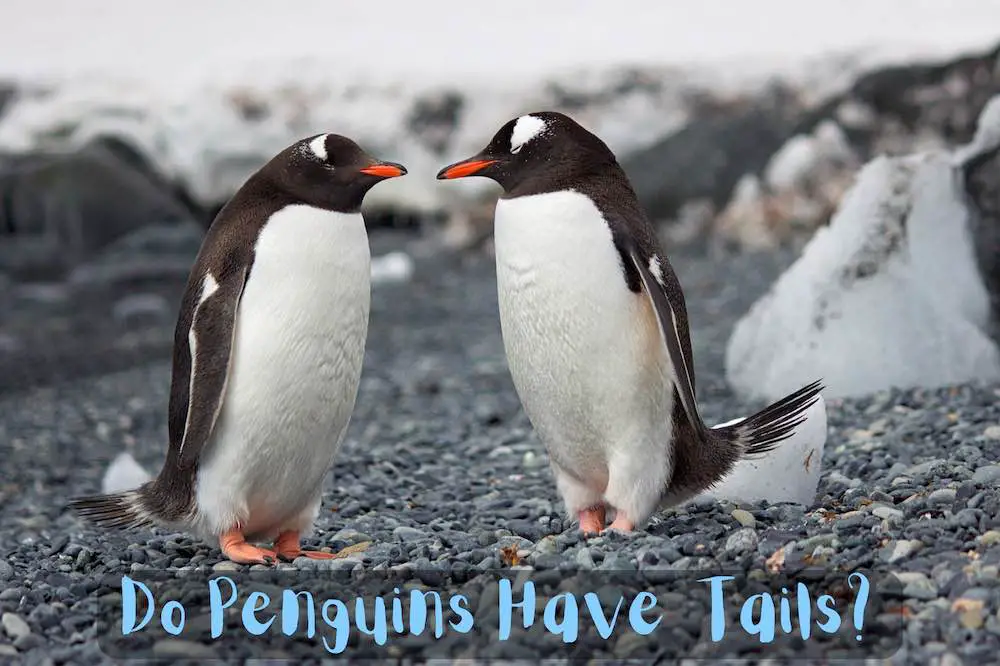Do penguins have tails, and if so what do they use them for? I wanted to know the answer to this, so did some research to find out more.
If you would like to know the answer to this, plus some really interesting information about what a penguin uses its tail for, then keep reading.
So then do penguins have tails? Yes penguins do have tails. They are usually short and stubby, although there are some breeds of penguins that can have tails up to 40cm in length. Penguins can use their tails to steer in the water, for balancing, and for preening or cleaning. Scientists also use penguins’ tails to help them!
The above is a very short answer to the question of do penguins have tails.
I’ve gone into a lot more detail below about what these look like, what they are used for, and how scientists use a penguin’s tail to help in their conservation. Read on below to find out more about this.
Contents
Do Penguins Have Tails?

So then do penguins have tails? Well the short answer to this, as I said above is yes. We also need to remember though that there is not just one type of penguin.
In fact there are actually 18 recognised species of penguins, and so in answering this question, we need to take this into account.
As I said the short answer is that yes penguins do have tails. What this looks like varies between the different types of penguins. Interestingly enough, and not many people know this, but penguins also have knees too!
Some breeds such as the gentoo and adélie penguins tend to have much longer tails than some of the other penguin breeds.
Penguins are very well designed for the environments in which they live. A product of natural evolution, as are all living creatures, penguins have specific characteristics that help them to survive in their natural habitats.
For example, penguins have excellent eyesight. Their eyes allow them to see both above and below water. They can see in very dark conditions, so can dive deep in waters to hunt for food. They have even been known to sleep underwater.
Penguins also have a special sweat gland that allows them to secrete the sometimes vast amounts of salt taken in while swimming in the sea for hours. As penguins don’t actually pee, this allows them to secrete this salt in a different way.
The point I am making in the above is that penguins, like other animals, have physical characteristics that support them in surviving in their environments. Penguins mostly live in very cold habitats, and so are adapted to these environments.
The fact that most of these penguins have a short and stubby tail is more than likely because there is not much use for a longer tail.
I will discuss a little more below about what a penguin’s tail looks like, if they actually have any uses for it, and some interesting facts about how scientists actually make use of their tails in studies.
What Does A Penguin’s Tail Look Like?
So if the answer to the question of do penguins have tails is a yes, then what do they look like? Like I said above, there are 18 different species of penguins, so there is going to be some variation between the different species of penguin.
Generally speaking, a penguin’s tail tends to be very short and stubby. Normally no more than a few centimetres in length. Again this is mostly because there is not too much use for a longer tail.
A penguin’s tail is usually rather stiff, not allowing for too much movement.
There are some breeds of penguin that have tails that are much longer than this. Collectively known as brush-tailed penguins, some breeds such as the chinstrap and adélie penguins have considerably longer tails.
Their tail feathers can actually grow up to 40 centimetres in length, which is much longer than some of the other breeds of penguin.
What’s In A Penguin’s Tail?
So we’ve answered the question of do penguins have tails. We know it’s a yes, and we know now what they look like. They are generally short, stubby and stiff, although also we know there are some breeds of penguin with considerably longer tails.
So what then is in a penguin’s tail? What is it made of? The answer to this is really quite simple. A penguin’s tail, like those of flighted birds, is made up of feathers.
Those penguins that have the short, stubby tails, will usually have somewhere in between 14 and 18 short tail feathers.
The penguins such as the chinstrap and adélie penguins simply have longer tail feathers. As I said above, these can measure up to 40cm in length.
So like the birds you see around you with longer tail feathers, a penguin’s tale is simply made up of a collection of feathers.
How Do Penguins Use Their Tails?
I have compared penguins in this article to flighted birds, and of course a penguin does not fly at all. It is a flightless sea bird. For this reason a penguin will use its tail in different ways from their flying counterparts.
So why do birds that fly have tails, and what do they use them for? Flighted birds will use their tail as part of the flying process. More specifically, they will use their tail to help them when landing.
Here, their tail acts as a kind of counterbalance when landing, allowing them to land safely without tipping back. There are also some birds with stiff tail feathers, such as woodpeckers, that will use their tail to prop themselves up. They will usually do this when sitting on branches, and to aid them when climbing vertical tree trunks.
Now as we know, penguins do not fly. So they do not need a long tail to act as a counterbalance when landing. This is in contrast to those birds that fly.
There are some similarities though. The penguins such as the chinstrap and adélie penguins will actually use their tails to help them balance, resting back on their longer tail feathers.
Where a penguin’s tale is of most use to them is of when they are in the water. This is where they spend a lot of their time, and they are exceptionally strong swimmers. Not surprisingly, a penguin will make use of its tail when swimming.
As I said above, penguins have adapted over many years to survive in their surroundings. Their tail is no exception.
A penguin will use its tail when swimming to act as a kind of rudder. Much like a boat has a rudder to help it steer, so the penguin has its tail. When gliding though the water, a penguin can use its tail to help it steer in different directions, thus making the process of swimming easier.
How Are Penguin’s Tails Helping Researchers?
So I’ve told you a little bit about why penguins have tails, or more specifically what they use their tails for. But I did find something interesting about how scientists are using the tails of penguins in their research.
Yes you did read that correctly. There are some scientists out there studying penguins by specifically looking at their tails. In a study by Michael Polito of Louisiana State University, tags were attached to 52 penguins to track their movements.
They looked specifically at where they searched for food, and tracked their migration habits. This research was carried out in order to better understand their habits as this is critical to the conservation of penguins.
Some breeds of penguin, like many other animals, have numbers that are in decline. This is not due to penguins being hunted in the way that other animals may be. It is actually illegal to eat or kill penguins. Also penguins don’t tend to attack humans, so they are not likely be killed in battle either!
One of the major threats to a penguin is the changing of their environment due to pollution and global warming.
As well as using these trackers to discover where the penguin has been in search of food, the researchers also took a tail feather from the brush-tailed penguins I talked about above.
The scientists were able to identify certain chemicals in these feathers. This came from amino-acids in tiny plant-like organisms that the penguins ate. The scientists were then able to track exactly which parts of the ocean the penguins had been swimming in for food.
So a penguin’s tail can prove useful for scientists, and even support them in the conservation of penguins.
Why Do Penguins Shake Their Tails?
You might think it odd that I’ve included this question in a post answering the question do penguins have tails. It was just something I came across while I was researching this post and it made me smile. So I thought I would include it.
So why do penguins shake their tales? Well in the water they may shake their tail quickly in order to help them turn quickly, maybe in search of food, or perhaps to avoid a predator.
But what about on land? Well penguins will shake at times in order to maintain homeostasis. What I mean by this is that they may do this in order to stay warm. Ever wondered why we shiver when we are cold? It’s to help the body maintain a healthy body temperature, something we call homeostasis.
Penguins will do the same as this. They will at times shake their entire bodies, and as a result of this, yes their tail will shake too.
Another answer to this question is related to the act of preening, or cleaning themselves. At the base of a penguins tale is an oil gland. Penguins can often be seen shaking their tail and pulling at it with their beak. This is so they can transfer some of this oil to their beak in order to clean or preen themselves with it.
Penguins can also be quite caring creatures too. Whilst this is not really related to their tail, an interesting fact I found out while I was researching this question is that penguins actually bury their dead!
Summing Up
So there you go. A comprehensive answer to the question of do penguins have tails. Way more information than I bet you thought you would get.
As you can see, penguins do have tails. Normally short and stubby in most penguins, in others they can be up to 40cm in length.
Penguins can use their tails to help them steer when swimming, and brush-tailed penguins can use their longer tails to help them balance.
Scientists can also use the feathers in a penguin’s tale to study their movements in order to protect and conserve them.
Penguins will also shake their tails for a number of reasons, one of which is to help them in their cleaning or preening process.
I hope you found the answer to the question of do penguins have tails useful.
If you have any questions or would like to leave a comment, then please do so below. Thanks for reading.

